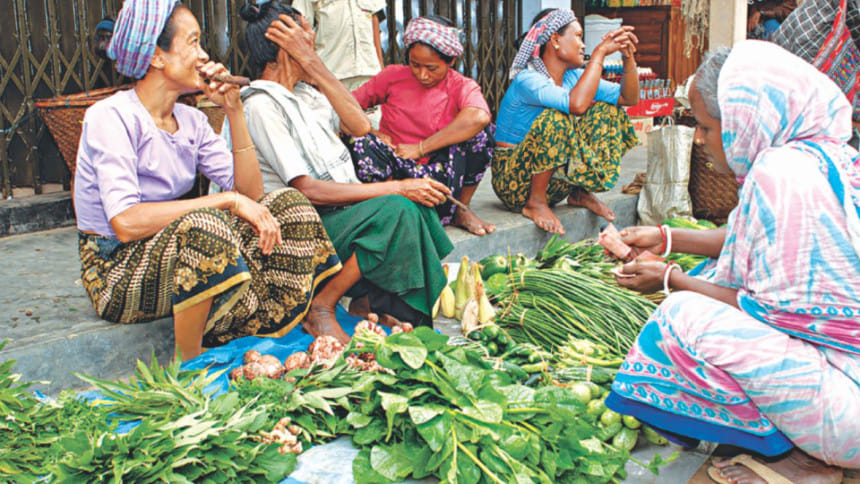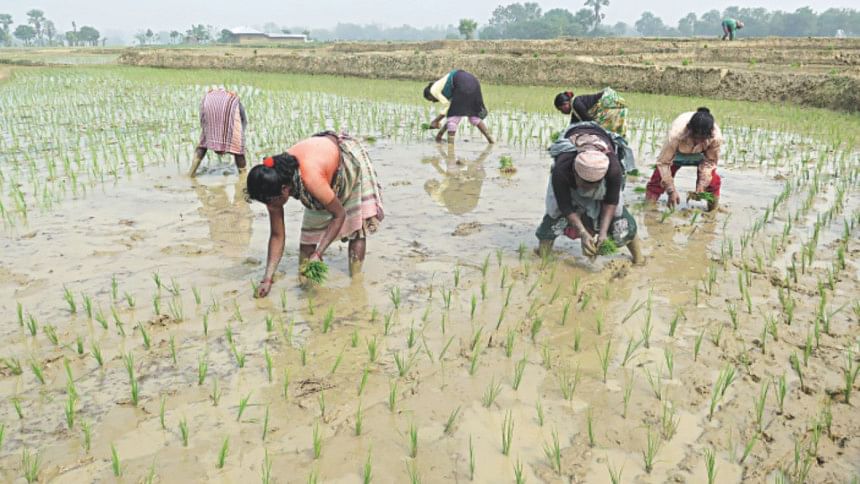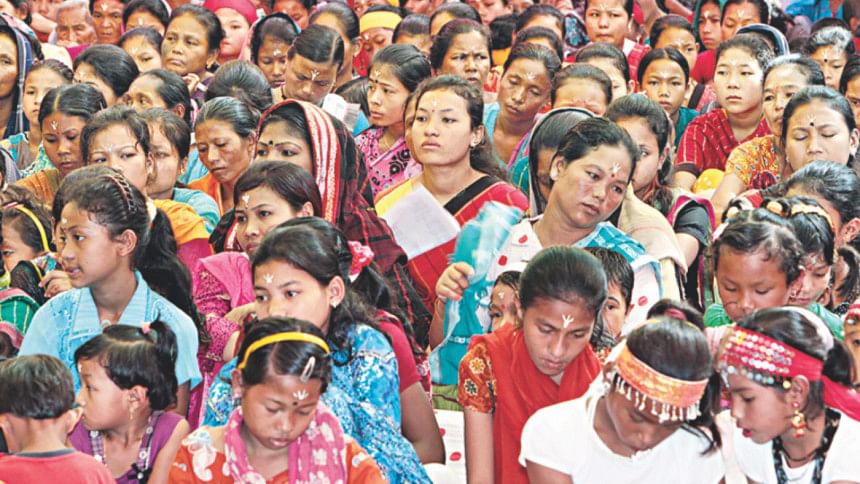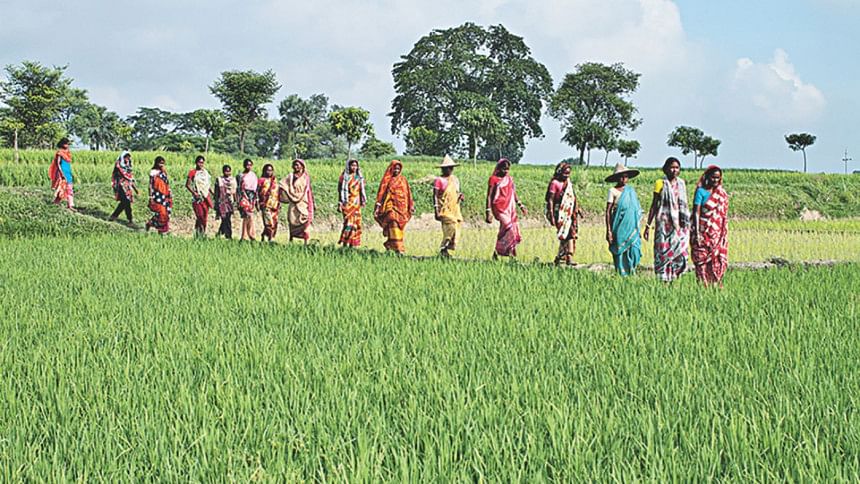Purna Chisik and Satendra Nokrek have four daughters—Francila, Malita, Nomita and Malina—and two sons—Parmel and Sebastin. All six of the siblings have taken their family name, ‘Chisik’ from their mother Purna Chisik. This is normal for the Garo, the leading matrilineal society of Bangladesh.
In the Garo society, each individual belongs to the kinship group of the mother, not to that of the father. Daughters inherit land and other property. However, all daughters are not equal heiresses—one daughter, generally the youngest one, is chosen as nokna who inherits property and cares for her parents. Other daughters get land and other property, according to the wish of the mother. The sons get a tiny share of property, also at the discretion of the mother.
Purna Chisik of Dharati village in Kuragacha union in the Modhupur sal forest area selected her youngest daughter Francila Chisik as nokna. When Purna Chisik died in 2006, she left all her land—around 27 acres of chala (high) land and 6.9 acres of baid (low-land)—to her four daughters and two sons. This land amounts to 113 pakis (one paki is 30 decimals).
Her two sons were less fortunate in getting a share of their mother’s land—each getting two pakis (60 decimals). Three daughters—Malita, Nomita and Malina—got 3.3 acres each. The youngest daughter, Francilia Chisik, the nokna, got the rest, the biggest share of her mother’s property. Satendra Nokrek, Purna Chisik’s husband, who came to Dharati from another village, is now in his nineties. He lives with Francilia Chisik. He owns no property, but his daughters take very good care of him.
Francilia’s husband, Lipu Nokrek, is nokrom or resident son-in-law in the family. Lipu or their sons will not own or inherit Francilia’s land unless she voluntarily gives it to them.
What we see in Purna Chisik’s family about inheritance of land is more or less a common picture in the Garo society: the daughters inherit land and other property and the nokna gets the largest share. The son generally leaves his mother’s house and goes to his wife’s family as resident son-in-law.
However, the Garo matrilineality never implies that the women rule over Garo society. “It is true that women are owners of property, but protection of ownership and management is bestowed upon men,” says researcher and writer Subhas Jengcham. “It is the men who are omnipresent everywhere in society and they take advantage of all opportunities.”
“But matrilineality does help to give women a different status among the Garos than they have among the patrilineal people of the plains,” writes American anthropologist Robbins Burling in his book The Strong Women of Modhupur.
Burling is absolutely right. Women in the Garo society are equal to men. They may not qualify to become kamal (traditional healer and priest) and administer village courts (shalish), but they play a key role in educating their children, with equal attention paid to boys and girls. They make equal contribution to family income. They are seen working their own land, earning cash from work as day labourers, and drinking their favorite home-made rice beer chu alongside men.
Not all women, however, are fortunate to have enough land to work on, like the four daughters of Purna Chisik. Families having little or no land to work on send their daughters to work in beauty parlours. The Garo girls, young or aged, can travel to Dhaka independently and without a man accompanying her.
According to a 2018 survey of the Society for Environment and Human Development (SEHD), 1,131 Garo women or 6.8 percent of 16,644 Garo people from 44 forest villages in Modhupur work in beauty parlours. This is an astounding fact. Twin factors—land use change and independence of the Garo women—may have led to a large percentage of Garo women working in beauty parlours. It is to be noted that in Modhupur, a very high percentage of Garo households—from 56.5 percent to 84.7 percent—have leased their land to others, most of them Bangalee businessmen, for paddy, spice (ginger and turmeric in particular), pineapple and banana cultivation (SEHD survey 2018).
In Bangladesh, the only other matrilineal Adivasi community is the Khasi that lives in Sylhet Division. Like the Garo, Khasi women are the owners of land and they inherit their parents’ land.

The children also take their mother’s name. In case of separation of parents, the children stay with mothers in both Garo and Khasi societies.
The land issue among the Khasi is far more complex. In explaining the disputes over land, Gidison Pradhan Shuchiang, a myntri (head of punji) argues, “There are 15 Khasi punjis (villages) in the tea garden areas and we have disputes with the management in three of these gardens (Aslam and Kailin in Sreemangal upazila and Jhemaichhara in Kulaura upazila).”
Shuchiang further elaborates on the bigger land conflict between the Khasi and the forest department. “Eleven of 85 Khasi punjis in the Northeastern districts are well-established with land titles in the names of the Khasis,” reports Shuchiang. “In all but 15 punjis in the tea garden areas and 11 established ones, the Khasis have tension and disputes with the forest department. The Khasis claim they have been living on the land from time immemorial and the forest department gazetted that at a later stage.”
It is the myntri in a punji who is responsible for oversight of the land—a community property—that is distributed among the families. Right now, there are reportedly five women Khasi myntri. Women inherit land and participate in betel leaf cultivation—the key economic activity of the Khasi, sort out betel leaf, handle its sale, keep account books and do all other household chores—but they are perhaps not as vocal as the Garo women. In dealing with land issues with the forest department and the tea garden owners, it is mainly the myntri and males who are seen in the front line.
While Garo women move freely between their homes and cities in search of work and income, the Khasi women stay largely restricted to their punjis and betel leaf cultivation, their key economic activity. The Khasi women are also not seen working in the tea gardens that may be next to their punjis. Both Garo and the Khasi are matrilineal but the contrast between the Garo women and the Khasi women is very dramatic.
However, what is common about both Garo and Khasi is that the overwhelming majority of them are Christians, educated and exposed to the modern world. The men in these two matrilineal societies are also increasingly claiming their rights over property in various forms. Men from these matrilineal societies who have employment and earnings can hold property they have earned in their own names. They can also distribute their earned property equally among children. Many want their inheritance traditions changed, as reflected in the words of Subhas Jengcham—”In the Garo society, we want nokna and nokrom traditions changed so that women and men get equal share in their parents’ property.”

The other Adivasi communities around the country—be it in the plains or in the Chittagong Hill Tracts (CHT)—are all patriarchal and patrilineal. The ownership and inheritance of land among the Santal, Oraon, Munda, Koch and dozens of other ethnic communities in the Northwest, North-center and northeast (outside the tea gardens) are strongly influenced by Hindu law and customs. A woman in these communities does not own or inherit land unless her father or brother has willed it to her. It is only men in these societies who inherit land and property. A woman can use land and property after her father’s death if she does not have brother(s), but even then, it will revert to her uncle(s) or their sons, if any. But one thing about the women in these ethnic communities—from numerous Santal to tiny Kadar in Dinajpur—is that they are seen as hard working, engaged in wage labour and other menial work to grow crops and feed their families.
In the tea gardens, there are as many as 80 non-Bengali ethnic communities with a population of half million. Women constitute more than 50 percent of the workforce in 160 tea gardens in the Sylhet Division and Rangamati; and more than 90 percent of the tea leaf pickers are women. They live in the labour lines in tea gardens. An appalling truth is that they own no land. Of 113,663.87 ha of public land granted for production of tea, 12,291.88 ha are khet or paddy land that the tea workers can only cultivate under restrictions. They do not have titles for these pieces of land. Attempts to take away khet land by the tea garden owners or government have always been a deep concern for the tea workers.
Women in the tea gardens adhere to the patriarchal and predominantly Hindu community and are absolutely landless. Belonging to the lowest rung in the Hindu casteism, they were uprooted from their homes in Bihar, Madras, Orissa, Andhra Pradesh, Madhya Pradesh, West Bengal, Uttar Pradesh and other places in India and had been brought to their current location to work in the tea gardens. Women workers do the most painstaking work in the field picking tea leaf all day. But they are completely bereft of land and property rights including their homesteads and the houses they live in. “In India, Hindu laws have changed significantly and Hindu women have been given right to land,” says Shamsul Huda, executive director of Association for Land Reform and Development (ALRD). “But in Bangladesh Hindu laws have not changed to award right to land and property to women.”
The Chakma, Marma, Tripura, Bawm, Mro, Khyang, Chak, Tanhchangya, Khumi, Lushai and Pangkhua in three hill districts in the Southeast and Rakhine in Cox’s Bazar are also patriarchal. According to customary laws, women in these communities do not generally own or inherit land. But unlike the plains, some variations are reported from the hill districts.
There are also initiatives to reform the customary laws and practices in these communities. “We, the Bawms, have recently reformed our customary laws and are attempting to give a fair share of our land and property to our women,” reports ZuamLian Amlai, former president of Bawm Social Council. “Other indigenous communities in Bandarban are also following our footsteps and attempting to reform customary laws to award rights to the women to land and property.”

Marma women in Bohmong circle (Bandarban) get some share in property. “Sons, daughters and the wife of a deceased person all attain absolute rights over property, which is divided following the Digest of the Burmese Buddhist Law (also known as Shamuhada Law),” says Han Han, a Marma researcher. “However, the wife and daughters of a deceased person (husband or father) in Marma community living in Mong circle (Khagrachhari District) and Chakma circle (Rangamati), do not attain any property right, unless the deceased have gifted or willed it prior to death.”
According to customary law in Bandarban, sons are entitled to get three-fourths of the property while wife and daughters get one-fourth. Sometimes the ratio is modified as ten-sixteenth for the son and six-sixteenth for the daughters. Also, there are examples of Marma households where mutual agreements had superseded the law.
Han Han also reports that in Chakma, Tanchangya and Mro inheritance laws, women have no right to landed property. “Deceased’s son(s) attain the absolute right over his or their father’s property,” explains Han Han. “Deceased’s wife (if remained unmarried) and unmarried daughters receive maintenance from the property. In absence (death) of son, deceased’s son’s wife (widow), son’s son and unmarried daughters receive maintenance until marriage from deceased’s property or directly inherit the property.”
One thing about women and land in the three hill districts is that they are visible everywhere. Their hard work and constant attention are crucial for the maintenance of jum (slash and burn cultivation) in the hills. They are the ones who do most of the harvest and manage the sale of crops from jum and fields. In other agricultural works, sale of labour, and every economic activity they participate along with the men. Their connection with land is symbiotic, which is true of other Adivasi women in the plains and tea gardens. Sadly enough, justice is not done to Adivasi women when it comes to the right to land and inheritance.
Philip Gain is researcher and director of Society for Environment and Human Development (SEHD).

